Information about Real del Monte, Mexico
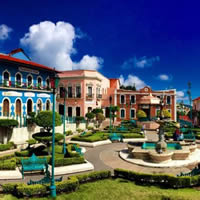 Fourteen kilometers north of Pachuca, draped across pine-clad hills, sits Real del Monte (aka Mineral del Monte), a once very wealthy silver-mining town, and, at over 2700m, a nice retreat from Mexico City. It is a quietly appealing place where you can wander around the well-tended streets, and carefully explore mining relics in the surrounding hills. The town’s architecture is largely Spanish colonial, but is given an odd twist by the almost exclusive use of red corrugated-iron roofing, and the existence of Cornish-style cottages with their double-pitched rooflines. Some 350 Cornish miners moved here after 1824 when a British company operated mines that were first opened by the Spanish in the mid-sixteenth century.
Fourteen kilometers north of Pachuca, draped across pine-clad hills, sits Real del Monte (aka Mineral del Monte), a once very wealthy silver-mining town, and, at over 2700m, a nice retreat from Mexico City. It is a quietly appealing place where you can wander around the well-tended streets, and carefully explore mining relics in the surrounding hills. The town’s architecture is largely Spanish colonial, but is given an odd twist by the almost exclusive use of red corrugated-iron roofing, and the existence of Cornish-style cottages with their double-pitched rooflines. Some 350 Cornish miners moved here after 1824 when a British company operated mines that were first opened by the Spanish in the mid-sixteenth century.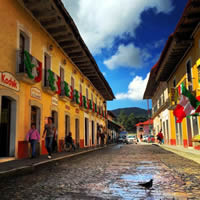 The mining Hospital founded in 1907, was created through the collaboration of barreteros and the Royal Company of Monte and Pachuca, in order to have a hospital for workers, especially for those who suffer accidents or chronic diseases acquired in the job performance. Today is a unique museum of its kind in Mexico. Keep facilities, furniture and medical equipment used since its opening. This museum is an interesting example of occupational medicine in our country and a means to know its history. Address: Calle Hospital No. 10, District Hospital, Mineral del Monte, Hidalgo, Mexico. Mina de Acosta (mine) began operations in 1727 and maintains its production activities until 1985. Today it has become a major museum where you can learn about its history and relevant aspects of mining. On the site are vestiges and architectural installations, testimony of its historical stages: the colony, immigration and British investment in the region by starting the steam era and advent of electricity with US investors. You will visit inside the mine where you will meet a vein of silver, after a historical overview of the mining work. Address: Road Warrior s / n. Barrio de San Jose de Acosta, Mineral del Monte, Hidalgo.
The mining Hospital founded in 1907, was created through the collaboration of barreteros and the Royal Company of Monte and Pachuca, in order to have a hospital for workers, especially for those who suffer accidents or chronic diseases acquired in the job performance. Today is a unique museum of its kind in Mexico. Keep facilities, furniture and medical equipment used since its opening. This museum is an interesting example of occupational medicine in our country and a means to know its history. Address: Calle Hospital No. 10, District Hospital, Mineral del Monte, Hidalgo, Mexico. Mina de Acosta (mine) began operations in 1727 and maintains its production activities until 1985. Today it has become a major museum where you can learn about its history and relevant aspects of mining. On the site are vestiges and architectural installations, testimony of its historical stages: the colony, immigration and British investment in the region by starting the steam era and advent of electricity with US investors. You will visit inside the mine where you will meet a vein of silver, after a historical overview of the mining work. Address: Road Warrior s / n. Barrio de San Jose de Acosta, Mineral del Monte, Hidalgo.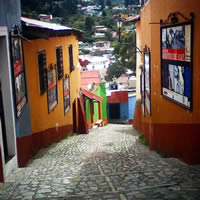 The Mina la Dificultad (mine) is located in Mineral del Monte (Real del Monte), in the adjoining district of Camacho and in the nineteenth century, with mines Jesus Maria Road, Ahuichote, The Tejocote and Vargas, belonging to the Company Mine aviator Pachuca and Real del Monte. The mine denounce the Lords did Martiarena the June 5, 1865, who after overcoming several obstacles, get possession of the mine and its excesses, along with his partner, Mr. Chester, in August 1866. At six, Chester Martiarena and are forced to resort to the system of accoutrement, making a contract with the Society of Esquipulas, the New; same that was absorbed by the Company of Real del Monte and Pachuca (CRMyP), four years later, so that the June 23, 1880, the difficulty becomes by the Real del Monte. The contract with this company accoutrement is stipulated that if the mines aviadas used machinery CRMyP should pay 10% of the extracted metal. In the event of need of "a local outlet of steam or winches in their own belongings, they would be charged to the account of accoutrement the cost of that drain", so that when ten years later, a Woolf machine is installed to the drain in the difficulty, whether their owners who absorb the full cost of the steam engine and the costs of the transfer and placement caused. In this type of contract it also states that "the management, administration and management of mines, including how to work them and the benefit of their metals were exclusive powers of Real del Monte Company." Such contracts accoutrement with small miners in the region, allowed the CRMyP expand their possessions and exercise full control over the regional mining. However, following the drop in the price of silver in the international market, a number of economic problems, exacerbated by low production of the mines of Pachuca, and flooding various laboratories in Real del Monte. The best perspective to continue the productive life of the district, was the exploitation nail San Ignacio, located 280 meters from the shooting of difficulty, on the grain of St. Agnes, with a width of between 10 and 14 poles, produced weekly $ 25,000.00 in 1866. The only downside was that the drainage elements with which it had proved insufficient to continue their exploitation; hence the decision to buy a machine with more power to ensure the continuity of production was taken. After several studies by engineers Andres Aldasoro and Manuel Contreras and Mr. José de Landeros and Cos, and Rodolfo Muñoz, it was decided to install the machine in the shooting of difficulty. Mina la Dificultad , now transformed into a site museum and interpretation center, is the most important monumental historical set of Real del Monte and a valuable testimony of the great technological transformations, in the late nineteenth century in Mexico. Privileged to have the best examples of industrial mining heritage, the end of an era, the steam and the beginning of another electricity. Address: Carretera Pachuca-Tampico federal S / N Mineral del Monte, Hidalgo; Mount México.Real Hgo.
The Mina la Dificultad (mine) is located in Mineral del Monte (Real del Monte), in the adjoining district of Camacho and in the nineteenth century, with mines Jesus Maria Road, Ahuichote, The Tejocote and Vargas, belonging to the Company Mine aviator Pachuca and Real del Monte. The mine denounce the Lords did Martiarena the June 5, 1865, who after overcoming several obstacles, get possession of the mine and its excesses, along with his partner, Mr. Chester, in August 1866. At six, Chester Martiarena and are forced to resort to the system of accoutrement, making a contract with the Society of Esquipulas, the New; same that was absorbed by the Company of Real del Monte and Pachuca (CRMyP), four years later, so that the June 23, 1880, the difficulty becomes by the Real del Monte. The contract with this company accoutrement is stipulated that if the mines aviadas used machinery CRMyP should pay 10% of the extracted metal. In the event of need of "a local outlet of steam or winches in their own belongings, they would be charged to the account of accoutrement the cost of that drain", so that when ten years later, a Woolf machine is installed to the drain in the difficulty, whether their owners who absorb the full cost of the steam engine and the costs of the transfer and placement caused. In this type of contract it also states that "the management, administration and management of mines, including how to work them and the benefit of their metals were exclusive powers of Real del Monte Company." Such contracts accoutrement with small miners in the region, allowed the CRMyP expand their possessions and exercise full control over the regional mining. However, following the drop in the price of silver in the international market, a number of economic problems, exacerbated by low production of the mines of Pachuca, and flooding various laboratories in Real del Monte. The best perspective to continue the productive life of the district, was the exploitation nail San Ignacio, located 280 meters from the shooting of difficulty, on the grain of St. Agnes, with a width of between 10 and 14 poles, produced weekly $ 25,000.00 in 1866. The only downside was that the drainage elements with which it had proved insufficient to continue their exploitation; hence the decision to buy a machine with more power to ensure the continuity of production was taken. After several studies by engineers Andres Aldasoro and Manuel Contreras and Mr. José de Landeros and Cos, and Rodolfo Muñoz, it was decided to install the machine in the shooting of difficulty. Mina la Dificultad , now transformed into a site museum and interpretation center, is the most important monumental historical set of Real del Monte and a valuable testimony of the great technological transformations, in the late nineteenth century in Mexico. Privileged to have the best examples of industrial mining heritage, the end of an era, the steam and the beginning of another electricity. Address: Carretera Pachuca-Tampico federal S / N Mineral del Monte, Hidalgo; Mount México.Real Hgo.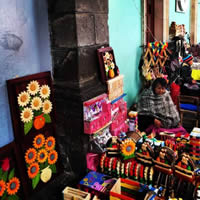 The British pulled out in 1848, to be replaced by a Mexican successor firm, but many of the miners and their Cornish influence remained, resulting in surprisingly authentic Cornish pasties and the introduction of fútbol (soccer), which was played for the first time on Mexican soil here in Real. Indeed, this British community in Mexico went on to found Pachuca football club and the Mexican football league. Many of the miners, who were Methodist rather than Catholic, now rest in the British cemetery (Panteón Inglés) on the edge of town.
The British pulled out in 1848, to be replaced by a Mexican successor firm, but many of the miners and their Cornish influence remained, resulting in surprisingly authentic Cornish pasties and the introduction of fútbol (soccer), which was played for the first time on Mexican soil here in Real. Indeed, this British community in Mexico went on to found Pachuca football club and the Mexican football league. Many of the miners, who were Methodist rather than Catholic, now rest in the British cemetery (Panteón Inglés) on the edge of town.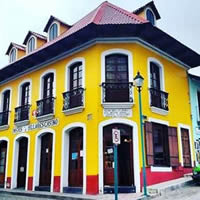 On the Jewish hill stands the British Pantheon. You can walk through a walkway that begins at the Dolores mine. Arriving observes the wrought iron gate at the entrance of the Pantheon, it is crowned with maximum "Blessed are those who die in the Lord" and designates the year 1862, however, Pantheon there is the grave of Robert Tindal, whose tombstone is designated as the year of his death 1934. What makes suppose that the Pantheon may date from before 1862. Entering you will experience some kind of strange feeling hard to describe, you'll notice that the tombs are primarily masonry and some marble, surrounded by plants and shaded by trees. Masonic symbols also call your attention. The tombs are perfectly aligned west to east, as if they saw heading to Great Britain, the location where the blood of most of those who lie there -751 until 14 March 2009- came. But one of Ricardo Bell died in 1875, whose tomb is at an angle of 90 degrees relative to the other. In this Pantheon, no only the British were buried, but also Scottish, Irish, Chinese, German, a Dutch and Mexican descendants of these adventurers who forged important chapters in the history of Real del Monte. Don "Chencho" and Carmen have many stories and legends that tell the Pantheon and the Real del Monte, visit them, approach them, ask them to tell you stories, listen, the passion with his British legacy.
On the Jewish hill stands the British Pantheon. You can walk through a walkway that begins at the Dolores mine. Arriving observes the wrought iron gate at the entrance of the Pantheon, it is crowned with maximum "Blessed are those who die in the Lord" and designates the year 1862, however, Pantheon there is the grave of Robert Tindal, whose tombstone is designated as the year of his death 1934. What makes suppose that the Pantheon may date from before 1862. Entering you will experience some kind of strange feeling hard to describe, you'll notice that the tombs are primarily masonry and some marble, surrounded by plants and shaded by trees. Masonic symbols also call your attention. The tombs are perfectly aligned west to east, as if they saw heading to Great Britain, the location where the blood of most of those who lie there -751 until 14 March 2009- came. But one of Ricardo Bell died in 1875, whose tomb is at an angle of 90 degrees relative to the other. In this Pantheon, no only the British were buried, but also Scottish, Irish, Chinese, German, a Dutch and Mexican descendants of these adventurers who forged important chapters in the history of Real del Monte. Don "Chencho" and Carmen have many stories and legends that tell the Pantheon and the Real del Monte, visit them, approach them, ask them to tell you stories, listen, the passion with his British legacy.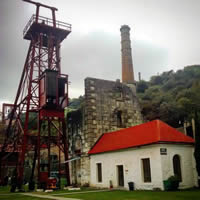 Visit Real del Monte at the beginning of the year and enjoy the Sweet Festival in honor of the patron saint of miners place: the Lord of Zelontla. During this festival a religious procession accompanied by sports, artistic and cultural events is performed. Visit the Festival de la Plata on June 11, where traders and craftsmen offer the best of their production. And could not miss celebrating the pride of the region: The Paste, whose annual festival is held in October. You cannot leave without tasting the rich pastes, do it in different outlets, compare styles, quality and taste. Visit the Trade Portal where you can admire the famous cartoonist decorations Constantino Escalante. Enters the sanctuary of the Lord of Zelontla and repairs on the details of the robe of Christ Mining.
Visit Real del Monte at the beginning of the year and enjoy the Sweet Festival in honor of the patron saint of miners place: the Lord of Zelontla. During this festival a religious procession accompanied by sports, artistic and cultural events is performed. Visit the Festival de la Plata on June 11, where traders and craftsmen offer the best of their production. And could not miss celebrating the pride of the region: The Paste, whose annual festival is held in October. You cannot leave without tasting the rich pastes, do it in different outlets, compare styles, quality and taste. Visit the Trade Portal where you can admire the famous cartoonist decorations Constantino Escalante. Enters the sanctuary of the Lord of Zelontla and repairs on the details of the robe of Christ Mining.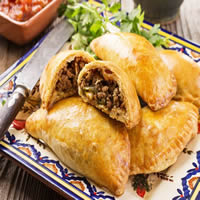 No matter where you go, in Real del Monte You cannot avoid eating all kinds of pastes and festival bread. Delve into history and discover the best places to eat their savory fillings, made from beans, potatoes and meat. Find out how miners ate the town, whose hands were stained for their work, and how much of the paste discarded. Try the local products prepared daily and from which you can taste fresh cream, tortillas, cured of pulque, bread, brown sugar and bread piglets pulque. To relax there are several options from which protrude and holistic spa hotels where you get in direct contact with nature.
No matter where you go, in Real del Monte You cannot avoid eating all kinds of pastes and festival bread. Delve into history and discover the best places to eat their savory fillings, made from beans, potatoes and meat. Find out how miners ate the town, whose hands were stained for their work, and how much of the paste discarded. Try the local products prepared daily and from which you can taste fresh cream, tortillas, cured of pulque, bread, brown sugar and bread piglets pulque. To relax there are several options from which protrude and holistic spa hotels where you get in direct contact with nature.MexicGo © 2023
